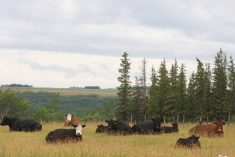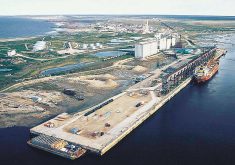It’s commonly believed that the world is at risk of running out of food and enough land to produce it.
It’s true that the world’s population continues to grow and an emerging middle class in developing economies is increasing the demand for a higher-quality diet. It’s also true that the number of hungry people on the globe has not fallen as far or as fast as many had hoped.
In fact, after decades of decline, those numbers have risen to about 821 million largely due to the effects of climate change and wars.
Read Also

Your best (and easiest) holiday dainty tray
Make-ahead recipes, store-bought goodies and co-operation with friends and family: Here’s how to throw together a stunning, low-stress tray.
However, generally speaking, the world’s farmers are doing their job and producing enough calories to feed everyone on the planet.
The fact that too much is being wasted, or there are problems of distribution, and poverty that makes what farmers produce inaccessible is not a function of farmers’ productivity. It’s a function of political will.
That’s an important distinction to remember when you hear the rhetoric about farmers having to increase productivity by 70 per cent — or more — in order to feed 9.8 billion people — or more — by 2050.
The discussion is now turning to the quality of nutrition available to the global population. That is quite a different story.
When University of Guelph researchers looked at what it would take to ensure everyone on the planet had access to a nutritious diet, they found global production of fruits and vegetables is falling short.
“We simply can’t all adopt a healthy diet under the current global agriculture system,” said study co-author Evan Fraser, holder of the Canada Research Chair in Global Food Security and director of University of Guelph’s Arrell Food Institute in a release. “Results show that the global system currently overproduces grains, fats and sugars, while production of fruits and vegetables and, to a smaller degree, protein is not sufficient to meet the nutritional needs of the current population.”
Researchers based their analysis on the “healthy eating plate” put out by Harvard University, which recommends half of our diet be made up of fruits and vegetables, with 25 per cent whole grains and 25 per cent protein, fat and dairy.
They looked at how much land is used today for farming and how much would be needed if everyone ate according to the guidelines.
They found that current practices produce 150 per cent of the servings of grain per person needed, three times the recommended servings of fat and oil, and four times the recommended servings of sugar. (In sugar’s case, the recommended intake for nutritional purposes is zero.)
But the world is producing only one-third of the recommended fruits and vegetables and two-thirds of the recommended protein.
That helps explain why there are 672 million people in the world categorized as obese. “What we are producing at a global level is not what we should be producing, according to nutritionists,” said Fraser.
Globally, research and development of cereals claims the lion’s share of investment, a holdover from the Green Revolution era when feeding the world was seen as purely a function producing more calories. As well, governments in exporting nations have subsidized production to support farmers and grow their economies.
Fat, sugar and salt-laden foods are typically an easy sell to consumers because they taste good. “All of these factors combined have resulted in a world system that is really overproducing these types of foods,” the researchers say.
Overproduction has resulted in narrower margins, which is prompting the world’s farmers to continuously search for more land to develop. It’s widely believed that if farmers moved toward less intensive farming systems, the pressure on undeveloped lands would intensify even further.
The fact is, that pressure on undeveloped lands is not driven by the world’s need for nutrition. It’s driven by farmers trying to make a living. The incentive to develop more land exists whether prices are high or low. Protection of those lands will be a function of policy, not market forces.
This research looks at what could happen if the two objectives were viewed separately.
The Guelph research team estimates that without any change, feeding 9.8 billion people by 2050 would require 12 million more hectares of arable land and at least one billion more hectares of pasture land.
Switching the focus to match dietary recommendations would reduce that pressure.
Feeding the world under that scenario would mean people replace some of their meat consumption with plant-based proteins. That combined with the fact that fruits and vegetables require less land to grow would reduce the amount of land required by 50 million hectares.
It’s food for thought.
















